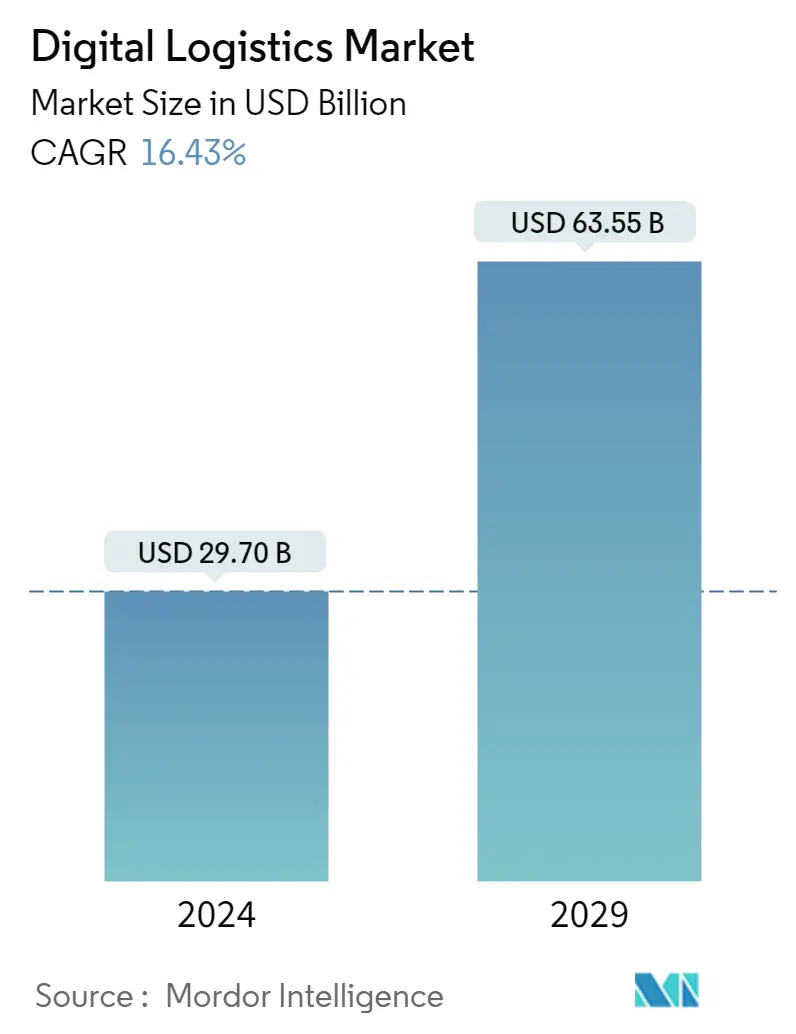Market Size of Digital Logistics Industry

| Study Period | 2019 - 2029 |
| Market Size (2024) | USD 29.70 Billion |
| Market Size (2029) | USD 63.55 Billion |
| CAGR (2024 - 2029) | 16.43 % |
| Fastest Growing Market | Asia Pacific |
| Largest Market | North America |
Major Players
*Disclaimer: Major Players sorted in no particular order |
Digital Logistics Market Analysis
The Digital Logistics Market size is estimated at USD 29.70 billion in 2024, and is expected to reach USD 63.55 billion by 2029, growing at a CAGR of 16.43% during the forecast period (2024-2029).
- Growth is driven owing to the increasing adoption of advanced technologies in the logistics sector. Moreover, these digital solutions are helping logistic companies in reducing incurred costs. Convergence of logistics and technology, along with cloud-based collaborative solutions that extend through the entire supply chain, tight integration of warehouse, transport, and end consumer information, and transparency through the supply chain are driving the growth of the market studied.
- The technological advancement in the digital market and rising cloud adoption are expected to fuel the demand for digital logistic solutions. For instance, in April last year, Locus and loconav announced a strategic cooperation. This partnership between loconav and Locus will promote digital transformation in the logistics sector by automating supply chain processes.
- With the outbreak of COVID-19, many industries have faced significant supply chain and logistic disruption owing to the lockdown imposed by various governments. Companies are transforming their supply chain capabilities with digital logistics platforms to meet those essential deliveries. According to Logistics News, digital supply chains using artificial intelligence and enabling digital payments are the solution to emergencies such as the Covid-19 pandemic.
- Over the past ten years, the e-commerce company has experienced tremendous growth due to the development of online shopping and Internet users. More rapid and efficient transportation providers are required due to the growth of e-commerce. When shopping online, customers expect accurate orders, prompt shipment, and return procedures. Businesses are looking for ways to reduce order shipping costs and timeframes. E-commerce is the driving force behind visibility, cost, ease of use, delivery speed, and hassle-free returns. New models and technologies must be created to accommodate this need by automating distribution routes, digitalizing logistics planning, and material movement. As a result, fulfillment services have become quicker and more varied, especially for last-mile delivery and refunds.
Digital Logistics Industry Segmentation
Digital logistics is driven by a new generation of web-based enterprise logistics applications that enable collaboration and optimization, leveraging a central logistics information backbone that provides visibility across the enterprise and extended supply chain.
The Digital Logistics Market is Segmented by Type (Inventory Management, Warehouse Management System (WMS), Fleet Management), by End-user Vertical (Automotive, Pharmaceutical / Life Sciences, Retail, Food and Beverage, Oil and Gas, and Other End-user Verticals) and by Geography. The market sizes and forecasts are provided in terms of value (USD) for all the above segments.
| Type | |
| Inventory Management | |
| Warehouse Management System (WMS) | |
| Fleet Management | |
| Other Types |
| End-user Vertical | |
| Automotive | |
| Pharmaceutical / Life Sciences | |
| Retail | |
| Food and Beverage | |
| Oil and Gas | |
| Other End-user Verticals |
| Geography | |
| North America | |
| Europe | |
| Asia Pacific | |
| Latin America | |
| Middle-East and Africa |
Digital Logistics Market Size Summary
The Digital Logistics Market is poised for significant expansion, driven by the increasing integration of advanced technologies within the logistics sector. This growth is largely attributed to the adoption of cloud-based collaborative solutions that enhance transparency and efficiency across the supply chain. The convergence of logistics and technology is enabling companies to reduce costs and improve operational efficiency. The demand for digital logistics solutions is further fueled by the rise of e-commerce, which necessitates rapid and efficient transportation, accurate order fulfillment, and streamlined return processes. Technological advancements, such as IoT and AI, are playing a crucial role in automating distribution routes and optimizing logistics planning, thereby enhancing the speed and reliability of delivery services.
The market is characterized by a fragmented landscape with numerous players catering to a diverse range of organizations, from SMEs to large enterprises. Key industry participants, including IBM Corporation, Advantech Corporation, and Samsung Electronics Co. Ltd., are actively involved in driving digital transformation within the logistics sector. Strategic partnerships and collaborations, such as those between Suttons International and LogChain, as well as SGTraDex and various shipping lines, are instrumental in fostering digital innovation and scalability. Additionally, regional initiatives in Asia-Pacific, particularly in China and India, are promoting the adoption of digital technologies to enhance logistical efficiency and reduce costs. These developments underscore the market's dynamic nature and the ongoing shift towards digital solutions in logistics.
Digital Logistics Market Size - Table of Contents
-
1. MARKET INSIGHTS
-
1.1 Market Overview
-
1.2 Industry Attractiveness - Porter's Five Forces Analysis
-
1.2.1 Bargaining Power of Suppliers
-
1.2.2 Bargaining Power of Consumers
-
1.2.3 Threat of New Entrants
-
1.2.4 Intensity of Competitive Rivalry
-
1.2.5 Threat of Substitute Products
-
-
-
2. MARKET SEGMENTATION
-
2.1 Type
-
2.1.1 Inventory Management
-
2.1.2 Warehouse Management System (WMS)
-
2.1.3 Fleet Management
-
2.1.4 Other Types
-
-
2.2 End-user Vertical
-
2.2.1 Automotive
-
2.2.2 Pharmaceutical / Life Sciences
-
2.2.3 Retail
-
2.2.4 Food and Beverage
-
2.2.5 Oil and Gas
-
2.2.6 Other End-user Verticals
-
-
2.3 Geography
-
2.3.1 North America
-
2.3.2 Europe
-
2.3.3 Asia Pacific
-
2.3.4 Latin America
-
2.3.5 Middle-East and Africa
-
-
Digital Logistics Market Size FAQs
How big is the Digital Logistics Market?
The Digital Logistics Market size is expected to reach USD 29.70 billion in 2024 and grow at a CAGR of 16.43% to reach USD 63.55 billion by 2029.
What is the current Digital Logistics Market size?
In 2024, the Digital Logistics Market size is expected to reach USD 29.70 billion.

